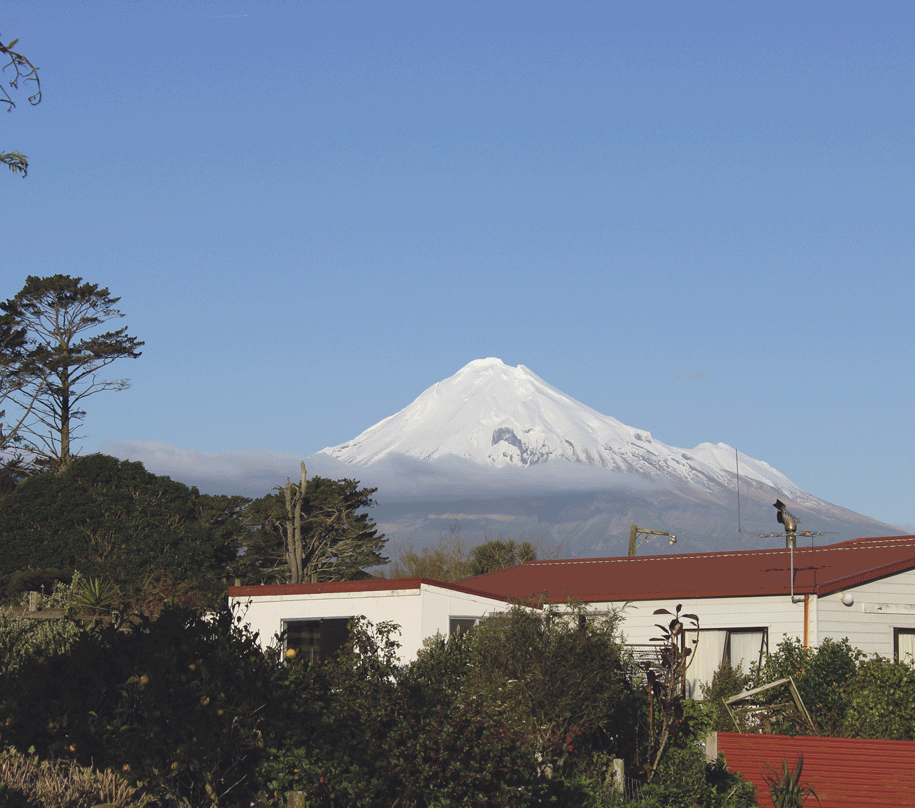
Mt Taranaki overlooking Parihaka community. Photo: Emily Benefield, Caritas.
July 2015
Education
Annette Scullion
Facing invasion in 1881, Parihaka leaders Tohu Kākahi and Te Whiti o Rongomai drew on the Gospel and their faith to ‘fight’ violence with peace. Their vision and courage preceded 20th century non-violent movements such as those led by Mahatma Ghandi and Martin Luther King.
The story of Parihaka in Aotearoa New Zealand’s history is the subject of a new education resource. Parihaka o neherā, o nāianei: Parihaka – past and present was launched by Bishop Charles Drennan, Parihaka community leader Dr Ruakere Hond and Caritas at the Catholic Education Convention, 10 June 2015.
The 26-page booklet for students, teachers and whānau was produced by Caritas Aotearoa New Zealand at Bishop Charles’ request.
Bishop Charles said, ‘The people of Parihaka encountered grave injustice. Unresolved tensions remain with people who have grown up in the region, and yet remain reluctant to accept anything but the sanitised settler account of history.
‘However, I am confident with increased knowledge and dialogue, a greater level of understanding and respect will emerge.
‘For those of us who belong to the Catholic Diocese of Palmerston North, of which Taranaki is a part, this story is of particular significance.’
Dr Ruakere Hond spoke of his vibrant Parihaka community today which shares a history of resilience and peaceful resistance stretching back 150 years. ‘Perhaps it is wrong to make assumptions that everyone knows about Parihaka and shares aspirations for peace,’ he said.
‘The Parihaka story has two key starting foundations. Its teachings and principles are found in the Bible; and in Parihaka we have a focus on providing sanctuary and safety for refugees.
‘The story of Parihaka, recognised by Caritas, is an opportunity for our tamariki to learn about it in schools. Parihaka is not just a history lesson. It is a legacy of principles with seeds to develop in this generation an understanding about conflict resolution and peace, love and caring.
‘We hope students and teachers throughout Aotearoa will be inspired to investigate the history of their own area after learning about Parihaka’s non-violent struggle for peace and self-governance.
‘Being encouraged to learn about the Māori account of history in an area and forming relationships with local Māori can also widen their perspective,’ Dr Hond said.
The new resource, suitable for students in Years 1 to 13, can be downloaded from www.caritas.org.nz/schools/parihaka-schools-resource or ordered from caritas@caritas.org.nz or ph (04) 496-1742.
+Charles E Drennan, Bishop of Palmerston North, provided the foreword for Parihaka o nehera, o naianei: Parihaka – past and present, as follows.
‘Turn the other cheek’ is a directive that comes from Jesus himself (cf. Mt 5:39; Lk 6:29). It is a ‘hard ask’. In the face of injustice what often first comes to mind is retaliation.
The people of Parihaka encountered grave injustice. Hostile colonial forces invaded their streets, fields and homes on 5 November 1881. How did they respond? That’s what you will learn about with this resource. Inspired by Scripture and prophetic courage, they decided to ‘fight’ violence not with more violence but with peace. They turned their cheek, and sang in their streets and offered bread to the invaders. Only faith in God can explain such a conciliatory response. The story of the peaceful resistance of the people of Parihaka is a treasure in the history of Aotearoa New Zealand. For those of us who belong to the Catholic Diocese of Palmerston North, of which Taranaki is a part, this story is of particular significance.
Indeed, we are humbled to learn that the descendants of Mahatma Gandhi and Martin Luther King, among others, now recognise that Tohu Kākahi and Te Whiti o Rongomai – their vision and the actions they inspired in others – are recognised as forerunners in the great tradition of non-violent resistance found across our globe.
Parihaka is not a museum. It is very much a living community of people who continue to strive to uphold the values of their tūpuna: caring for their land and people, and working peacefully with determination for a future that will sustain and nurture their mokopuna and the wider community.
I invite each of you – students, teachers and whānau – to explore this spiritual story not just with your head but your heart too: kia rangona a taringa, a ngākau hoki. In this way the spirit of Taranaki will be enriched. Indeed, up and down our beautiful country we can be prompted to know our story and learn from it too.
Together let us ponder the words Tohu and Te Whiti chose to place before their people as a guide, the words of the Angel announcing the birth of Jesus (cf. Lk 2:14).
He honore, he kororia ki te Atua i runga rawa,
he maungarongo ki te whenua,
he whakaaro pai ki nga tangata katoa.
Honour and glory to God above,
peace unto the land,
and goodwill to all people.